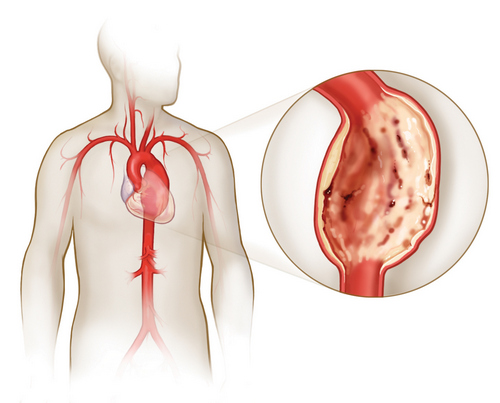Etiotropic therapy of myocarditis Abramov-Fiedler has not been developed. Symptomatic treatment of heart failure, arrhythmias, prevention of thromboembolic complications.
For this purpose, bed rest, diet therapy, medication (nitrates, cardiac glycosides, diuretics, ACE inhibitors, beta-blockers, aldosterone receptor antagonists, anticoagulants) are prescribed.
Anti-inflammatory therapy includes the appointment of NSAIDs (indomethacin, diclofenac); in severe forms of myocarditis Abramov-Fidler with a high activity of immune reactions, glucocorticoids are used; with allergic background – desensitizing agents. Additionally, drugs of metabolic action (cocarboxylase, inosine, potassium orotate, vitamins) are used. For giant cell myocarditis, a heart transplant is indicated.
In cardiology, Abramov-Fiedler’s myocarditis is regarded as an extremely severe form of non-rheumatic myocarditis with a high mortality rate. Abramov-Fiedler’s myocarditis usually occurs in young and relatively healthy people. The average age of patients with idiopathic myocarditis is 42 years; The percentage of people of both sexes among the patients is about the same. The disease was first described by a Russian doctor S. S. Abramov in 1887; isolated in a separate nosological form in 1897 by the German clinician K. Fiedler.
Abramov-Fiedler’s idiopathic myocarditis (malignant, isolated, allergic, interstitial myocarditis) is a myocarditis with an unclear etiology characterized by deep diffuse inflammatory, degenerative and degenerative changes in the heart muscle.
Causes of idiopathic myocarditis Abramov-Fiedler
The name of Abramov-Fiedler’s myocarditis, idiopathic, indicates an unclear etiology of the disease. A number of researchers (A.I. Abrikosov, Ya.L. Rapoport and others) substantiated the allergic nature and the autoallergic mechanism of the development of Abramov-Fiedler’s myocarditis. Often it is preceded by serum sickness, eczema, and drug allergies. In recent years, the role of other possible trigger factors that trigger the mechanisms of idiopathic myocarditis, in particular, viral infection and autoimmune reactions, has been discussed.

The hypothesis of viral genesis of Abramov-Fiedler’s myocarditis is confirmed by statistical data: in patients who have experienced acute viral myocarditis, chronic idiopathic myocarditis occurs in 4-9% of cases against 0.005% in the general population. There is a point of view that Abramov-Fiedler’s myocarditis is an extreme variant of infectious-allergic myocarditis.
Approximately 20% of patients develop Abramov-Fidler’s myocarditis on the background of autoimmune diseases: Takayasu’s disease, Hashimoto’s thyroiditis, Crohn’s disease. The immunopathological mechanism of inflammation is indicated by the identification of antibodies to myocardium and cellular cytotoxicity.
Typical morphological signs of Abramov-Fidler’s myocarditis are: isolated heart damage, a combination of extensive dystrophic, infiltrative-inflammatory myocardial changes with widespread cardiosclerosis, intracardiac thrombosis and embolism of the arteries of the circulation.
Macroscopically, Abramov-Fiedler’s myocarditis reveals flabbiness of the walls and stretching of the heart cavities, the presence of wall clots; on a section – variegation of coloring of a myocardium. Microscopic examination draws attention to hypertrophy of muscle fibers (to a greater extent, papillary muscles and subendocardial layers of the myocardium); extensive fields of myolysis with replacement of connective muscle tissue; the presence of signs of coronaritis – inflammatory infiltrates along the small branches of the coronary vessels.
Classification of idiopathic myocarditis Abramov-Fiedler
On the basis of histological signs, four variants (types) of idiopathic myocarditis are distinguished: dystrophic, inflammatory-infiltrative, mixed and vascular. In the dystrophic (destructive) type of Abramov-Fiedler myocarditis, the processes of hydropic dystrophy of muscle fibers with their subsequent total death and myolysis in the affected area prevail.
Inflammatory-infiltrative idiopathic myocarditis is characterized by edema of the interstitial tissue and its infiltration with various cellular elements. In the acute stage, polymorphonuclear neutrophilic granulocytes or eosinophilic leukocytes are found in large quantities in the exudate. In the long run, plasma or multinucleated giant cells predominate in the infiltrate.
The mixed type of myocarditis Abramov-Fidler is a combination of dystrophic and inflammatory-infiltrative variants. The vascular type of myocarditis Abramov-Fidler occurs with a primary lesion of the small branches of the coronary arteries.
With the flow of myocarditis Abramov-Fidler can be acute (2-8 weeks), subacute (from 3 to 18 months) and recurrent chronic (lasts for years). Less common is the latent form of idiopathic myocarditis, which occurs without clear symptoms. According to clinical signs, there are asystolic, arrhythmic, thromboembolic, pseudo-coronary, and mixed forms of Abramov-Fiedler myocarditis.
Symptoms of idiopathic myocarditis Abramov-Fiedler
Abramov-Fiedler’s myocarditis is distinguished by a severe, often malignant course. In the acute form, symptoms of right ventricular or progressive total heart failure rapidly increase. Dyspnea, orthopnea, cyanosis, tachycardia, hypotension, edema, ascites, hepatomegaly and splenomegaly appear. Perhaps the development of cardiac asthma and pulmonary edema. Often there are cardiac pain, resembling angina. In the acute stage, an increase in body temperature to 38–39 ° C is observed.
Sometimes the leading in the clinic is thromboembolic syndrome; in this case, the disease can manifest with pulmonary embolism, thromboembolism of cerebral, renal, splenic vessels. The lightning fast myocarditis of Abramov-Fiedler is always fatal.
In chronic form of myocarditis Abramov-Fiedler, the course of the disease is recurrent; after each exacerbation, myocardial fibrosis, cardiomegaly and irreversible circulatory disorders are steadily progressing. There are cases of latent myocarditis Abramov-Fiedler, leading to sudden death.
Diagnosis of idiopathic myocarditis Abramov-Fiedler
During physical examination, there is a frequent, irregular, weak filling pulse; percussion expansion of the borders of the heart; auscultatory phenomena (gallop rhythm, systolic murmur in the projection of the apex of the heart), deafness of heart tones, etc. In the lungs finely bubbling moist rales, crepitus are heard. Symptoms of total heart failure are peripheral edema, enlargement and tenderness of the liver, ascites.
Biochemical blood tests in myocarditis Abramov-Fidler detect an increase in C-reactive protein, fibrin, seromucoid, haptoglobin, a- and γ-globulins, creatine kinase, and troponin T activity. antibodies to ds DNA and antinuclear antibodies).
Radiography of the chest, reveals a significant increase in the size of the heart, signs of venous congestion in the lungs. Echocardiography allows to exclude other causes of heart failure (amyloidosis of the heart, congenital heart defects, etc.); detect pericardial effusion, dilatation of heart cavities, myocardial hypertrophy, intracavitary blood clots; evaluate the mobility and thickness of the walls.
The ECG changes in Abramov-Fidler’s myocarditis are not specific: sinus tachycardia, incomplete blockade of the bundle of His bundle, atrioventricular block, ventricular arrhythmia, ventricular fibrillation, rarely atrial fibrillation and extrasystole can be detected; in the case of myocardial tissue damage – a pseudo-infarction pattern that requires a differential diagnosis with coronary artery disease and myocardial infarction.
Coronary angiography for myocarditis Abramov-Fiedler indicate coronary ischemia due to cardiac dysfunction. For the detection of inflammation of the heart muscle, highly specific and sensitive methods are antimyosin scintigraphy, gadolinium-enhanced MRI of the heart.
The standard procedure for the diagnosis of myocarditis of various etiologies is myocardial biopsy, but this method is associated with a high frequency of both false-positive and false-negative results.
Forecast of idiopathic myocarditis Abramov-Fiedler
The course of myocarditis Abramov-Fidler in most cases unfavorably, the mortality rate is extremely high. Acute forms of the disease can end in death for several days or weeks, subacute – for several months. Death occurs from acute heart failure, ventricular fibrillation, less often thromboembolic complications.
Chronic and latent variants of idiopathic myocarditis lead to the progression of cardiomegaly and irreversible circulatory disorders. Specific prophylaxis of myocarditis Abramov-Fiedler has not been developed.



